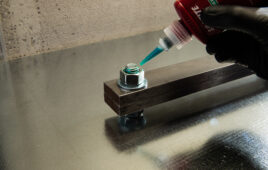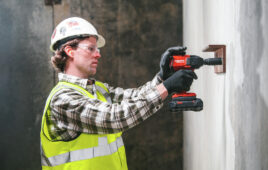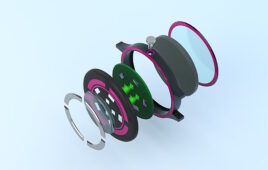When a handful of colleagues set up shop in Minnesota more than a century ago, not one would have predicted their efforts would lead to a multinational conglomerate corporation, with global corporate operations in 70 countries and sales offices in another 200 locations.

Bonding tape has advanced to offer reliable use in several different applications. Here, 3M X-Series Hi-Tack Transfer Tape is applied for recreational vehicle panel bonding.
The founders of 3M Company — an acronym for Minnesota Mining and Manufacturing — were simply mining for corundum, a mineral ideal for making sandpaper and grinding wheels.
However, their mining efforts fell short, and corundum was never found. After a couple of years of persistence, they finally decided to purchase the necessary abrasive minerals from another source and constructed their first manufacturing building in 1905 — a two-story sandpaper plant in Duluth.
Bad luck seemed to follow. Not long afterward, the floor collapsed in the new facility as a result of the weight of the equipment and raw materials. Still, the 3M team persisted. In 1910, they hit a break. The company moved to a more central location in St. Paul, which helped visibility, and a few years later launched its first exclusive product: 3M Three-M-ite Abrasive Cloth. It could be used for commercial and industrial wood or metal sanding jobs.
“It’s a unique story,” shares Scott Buss, Director, Global Key Accounts, Industrial Adhesives and Tapes Division at 3M. “While 3M started as a mining company struggling with sales, particularly in relation to mineral anorthosite, it eventually managed to successfully sell abrasives to the automotive industry — and to Ford, in particular.”
The Three-M-ite cloth was just the start. Afterward, the company introduced the world’s first water-resistant and coated abrasive, 3M Wetordry Waterproof Sandpaper. It quickly became of interest to the auto industry because it let manufacturers use the product with water to reduce dust and decrease the friction that typically marred into a vehicle’s finish.

3M’s headquarters in St. Paul, Minnesota.
“Then, one of our lab employees at the time overheard that two-tone cars were slowly becoming a thing. To achieve the two-tone look, an area was typically masked off using animal or natural-based glue and newspaper. So, they’d brush and mask off a car and then paint it,” Buss explains. “Long story short, this led to the invention of masking tape.”
If you ever wondered how or when the Scotch brand tape products were developed, it started with masking tape for the auto industry and advanced from there.
“A few years later, 3M developed transparent tape using cellophane, which is no longer made with cellophane, so I’ll refer to it as ‘magic tape’ or what most now call Scotch Tape,” he says. 3M keeps the exact recipe for its Scotch Tape (yes, the one used on wrapping paper) a trade secret. Not long after that, the company also invented the iconic, snail-like designed handheld tape dispenser.
This is the origin of how 3M became associated with tapes and bonding — and, eventually, adhesives.
“So much of what we’ve accomplished, and continue to accomplish, relates to assembling things and holding them together. We’ve noticed gaps in technology where we could invent a better or a previously non-existent solution,” he says. “But our work with adhesives really began early on and with learning how to best get minerals to bond to paper. To make sandpaper, the abrasive side needed to stick and hold up.”
Buss says demand for more industrial adhesives accelerated in the ’40s. “For example, 3M launched a neoprene rubber adhesive when natural rubber became short, primarily because of World War II.” It was initially used to bond hoses and gaskets. “This ability to assemble parts without a conventional fastener slowly began to gain more recognition and interest.”
In the ’50s and ’60s, structural adhesive films started being used in the aerospace sector to bond wings, fuselage components, and helicopter blades. “As an accepted practice, I’d say the aerospace industry was really one of the pioneering areas for adhesive use.”

3M Adhesive Sealant is applied over a seam to prevent fluid ingress or egress.
Today, 3M’s tapes and adhesives are found in aerospace, automotive, electronics, medical devices, office supplies, and other consumer products. The company currently has four large business groups — transportation and electronics, safety and industrial, health care, and consumer goods — with another 22 different divisions beneath them.
“What’s nice is that the material science 3M offers crosses from division to division and industry to industry. So, because all of the technology is owned by the company, it’s accessible to each division” he says.
Essentially, this allows for a large toolbox of R&D and product innovation to draw from. Considering more than 60,000 3M products are used in homes, businesses, schools, hospitals, and other industries, it’s clearly made sense to share this insight throughout the company.
Continued growth
Buss has certainly witnessed the growth. He began his career with 3M as a process engineer in the industrial sector, primarily manufacturing pressure-sensitive tapes. Then, he moved into an application engineering role where he became more of a technical liaison, helping solve questions and applications on behalf of customers.
“I stayed in that sector for about 28 years, working in business development, marketing, and sales. Now, I’m part of the global business management team and primarily focused on product assembly using liquid adhesives or pressure-sensitive tapes.” He’s seen the changes in industry demands and the evolution of adhesives over time.
“Today, you have multi-material designs with one purpose: to decrease costs. To meet this goal, there are application-dependent considerations,” he says. “One is to reduce weight, say for fuel efficiency in an airplane. Another is to distribute stress, which could mean energy absorption in the case of a vehicle crash. Then, there’s miniaturization, particularly in the electronics sector like for smartphones. Trends, such as light-weighting and miniaturization, mean new materials have to be introduced.”
Tapes and adhesives provide a solution that typically reduces the weight of an application, at least compared to mechanical fasteners, and offers micro-dispensing options for those miniature assemblies. They also meet multi-material designs.
“Take vehicles, for example, they were originally made of steel. Conventional fasteners or welding made sense because these options do better with thicker or similar materials. But now, cars are made of plastic, aluminum, and a mix of alloys and composites. Adhesives and tapes can join this range of materials…so, you can bond two different metals and not worry about galvanic corrosion, right? They also offer some energy absorption or vibration dampening,” he says. “It just makes sense.”

3M VHB Tape can be used on washing machines, and other such appliances, for decorative material attachments.
Despite early adoption by the aerospace industry, however, educating product designers and engineers about advances in adhesives has always been a large part of Buss’ job. It’s typically not taught in school.
“I was trained as a mechanical engineer and at the time, there were not too many young engineers and students learning about chemical bonding or attachment in my program or within the industry.” Buss went to the University of Minnesota. “While we were taught how to bend metal and how to select fasteners correctly, there was unfamiliarity with chemical bonding and some disbelief about its advantages.”
So that’s been the main focus of his career at 3M, especially during the last 15 years. “It’s important to us that we offer technical support and properly educate customers, ensuring they understand and fully realize the potential of an adhesive or a tape. By sharing insight from aerospace, transportation, and electronic markets, we can show how certain types of assemblies are well-suited to adhesives and can also derive benefits aside from just bonding.”
Additional benefits could include better overall aesthetics, process flow or production efficiency, or a performance benefit (such as light-weighting for fuel-efficiency in a vehicle) that would not be available through other fastening methods.
“However, I’m in no way suggesting it’s a competition between assembly methods. Mechanical fasteners, welding, and adhesives or tapes should all be complementary to one another and be used when and where ideal depending on the application,” says Buss. “Chemical bonding has advanced and offers several advantages that many design engineers are unaware of but could benefit from.”
And 3M is showing no signs of slowing down as it continues to innovate new options. This includes formulas with lower odor (common in chemicals) for improved worker comfort, reduced or non-flammability (so the adhesives are safer to store and transport), and greater sustainability features (such as fewer volatile organic compounds).
A personal touch
What’s unique about 3M’s offering is the team will also spend time with a design engineer, fully learning about his or her project and goals.

Scott Buss
“We want to ensure confidence and the right assembly method for a part, so we can help the designer model a tape or an adhesive into their part using finite analysis before fabricating it to gain that engineering confidence,” says Buss.
Finite element analysis is a software method for predicting how a product reacts to real-world conditions.
“There’s always new applications, new materials to bond or temperature ranges to comply with, or greater strength and durability measures to ensure,” adds Buss. “So, we’re always working to ensure success and extend what’s possible.”





Tell Us What You Think!